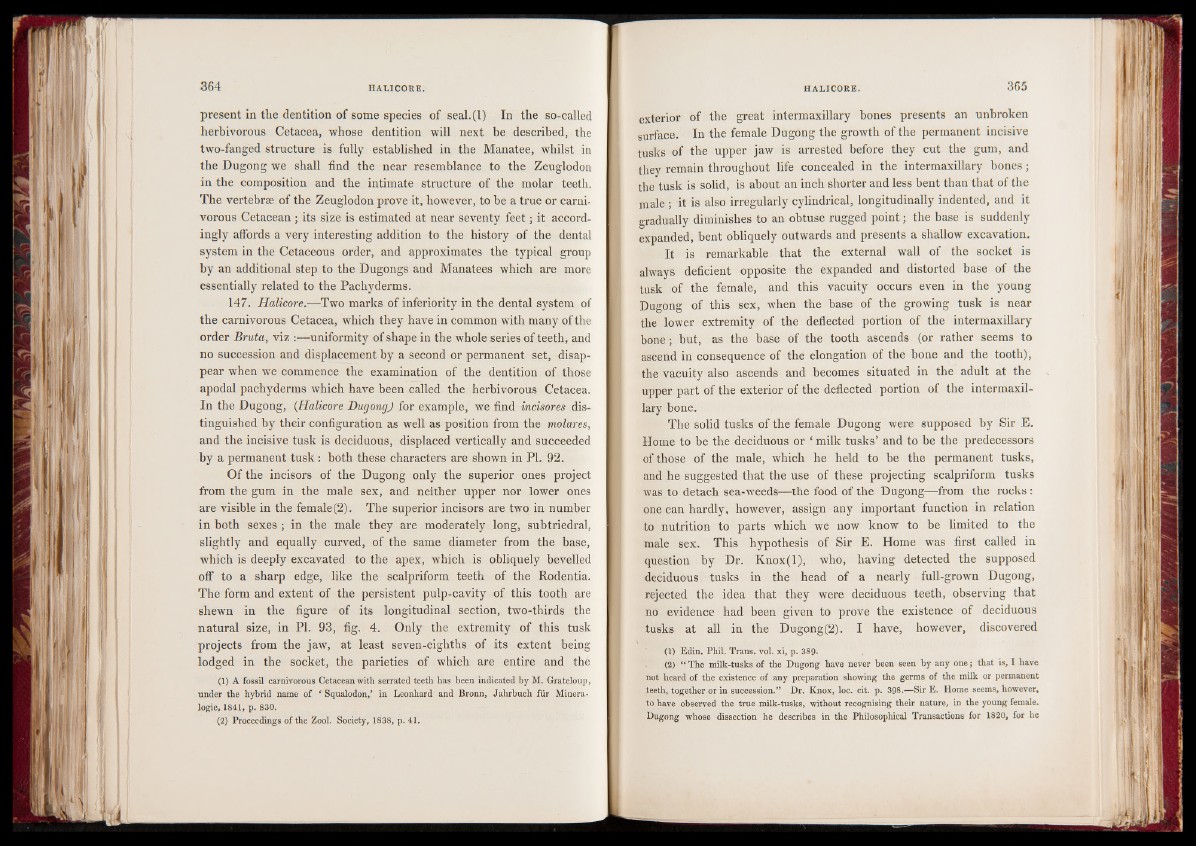
present in the dentition of some species of seal.(l) In the so-called
herbivorous Cetacea, whose dentition will next he described, the
two-fanged structure is fully established in the Manatee, whilst in
the Dugong we shall find the near resemblance to the Zeuglodon
in the composition and the intimate structure of the molar teeth.
The vertebra of the Zeuglodon prove it, however, to he a true or carnivorous
Cetacean ; its size is estimated at near seventy feet; it accordingly
affords a very interesting addition to the history of the dental
system in the Cetaceous order, and approximates the typical group
by an additional step to the Dugongs and Manatees which are more
essentially related to the Pachyderms.
147. Halicore.—Two marks of inferiority in the dental system of
the carnivorous Cetacea, which they have in common with many of the
order Bruta, viz :—uniformity of shape in the whole series of teeth, and
no succession and displacement by a second or permanent set, disappear
when we commence the examination of the dentition of those
apodal pachyderms which have been called the herbivorous Cetacea.
In the Dugong, (Halicore Dugong) for example, we find incisores distinguished
by their configuration as well as position from the molares,
and the incisive tusk is deciduous, displaced vertically and succeeded
by a permanent tusk : both these characters are shown in PI. 92.
Of the incisors of the Dugong only the superior ones project
from the gum in the male sex, and neither upper nor lower ones
are visible in the female (2). The superior incisors are two in number
in both sexes ; in the male they are moderately long, subtriedral,
slightly and equally curved, of the same diameter from the base,
which is deeply excavated to the apex, which is obliquely bevelled
off to a sharp edge, like the scalpriform teeth of the Rodentia.
The form and extent of the persistent pulp-cavity of this tooth are
shewn in the figure of its longitudinal section, two-thirds the
natural size, in PI. 93, fig. 4. Only the extremity of this tusk
projects from the jaw, at least seven-eighths of its extent being
lodged in the socket, the parieties of which are entire and the
(1) A fossil carnivorous Cetacean with serrated teeth has been indicated by M. Grateloup,
under the hybrid name of ‘ Squalodon,’ in Leonhard and Bronn, Jahrbuch fur Minera-
logie, 1841, p. 830.
(2) Proceedings of the Zool. Society, 1838, p. 41.
exterior of the great intermaxillary hones presents an unbroken
surface. In the female Dugong the growth of the permanent incisive
tusks of the upper jaw is arrested before they cut the gum, and
they remain throughout life concealed in the intermaxillary bones;
the tusk is solid, is about an inch shorter and less bent than that of the
male ; it is also irregularly cylindrical, longitudinally indented, and it
gradually diminishes to an obtuse rugged point; the base is suddenly
expanded, bent obliquely outwards and presents a shallow excavation.
It is remarkable that the external wall of the socket is
always deficient opposite the expanded and distorted base of the
tusk of the female, and this vacuity occurs even in the young
Dugong of this sex, when the base of the growing tusk is near
the lower extremity of the deflected portion of the intermaxillary
bone; but, as the base of the tooth ascends (or rather seems to
ascend in consequence of the elongation of the bone and the tooth),
the vacuity also ascends and becomes situated in the adult at the
upper part of the exterior of the deflected portion of the intermaxillary
bone.
The solid tusks of the female Dugong were supposed by Sir E.
Home to be the deciduous or ‘ milk tusks’ and to be the predecessors
of those of the male, which he held to be the permanent tusks,
and he suggested that the use of these projecting scalpriform tusks
was to detach sea-weeds—the food of the Dugong—from the rocks :
one can hardly, however, assign any important function in relation
to nutrition to parts which we now know to be limited to the
male sex. This hypothesis of Sir E. Home was first called in
question by Dr. Knox(l), who, having detected the supposed
deciduous tusks in the head of a nearly full-grown Dugong,
rejected the idea that they were deciduous teeth, observing that
no evidence had been given to prove the existence of deciduous
tusks at all in the Dugong(2). I have, however, discovered
(1) Edin. Phil. Trans, vol. xi, p. 389*
(2) “ The milk-tusks of the Dugong have never been seen by any one; that is, I have
not heard of the existence of any preparation showing the germs of the milk or permanent
teeth, together or in succession.” Dr. Knox, loc. cit. p. 398.—Sir E. Home seems, however,
to have observed the true milk-tusks, without recognising their nature, in the young female.
Dugong whose dissection he describes in the Philosophical Transactions for 1820, for he